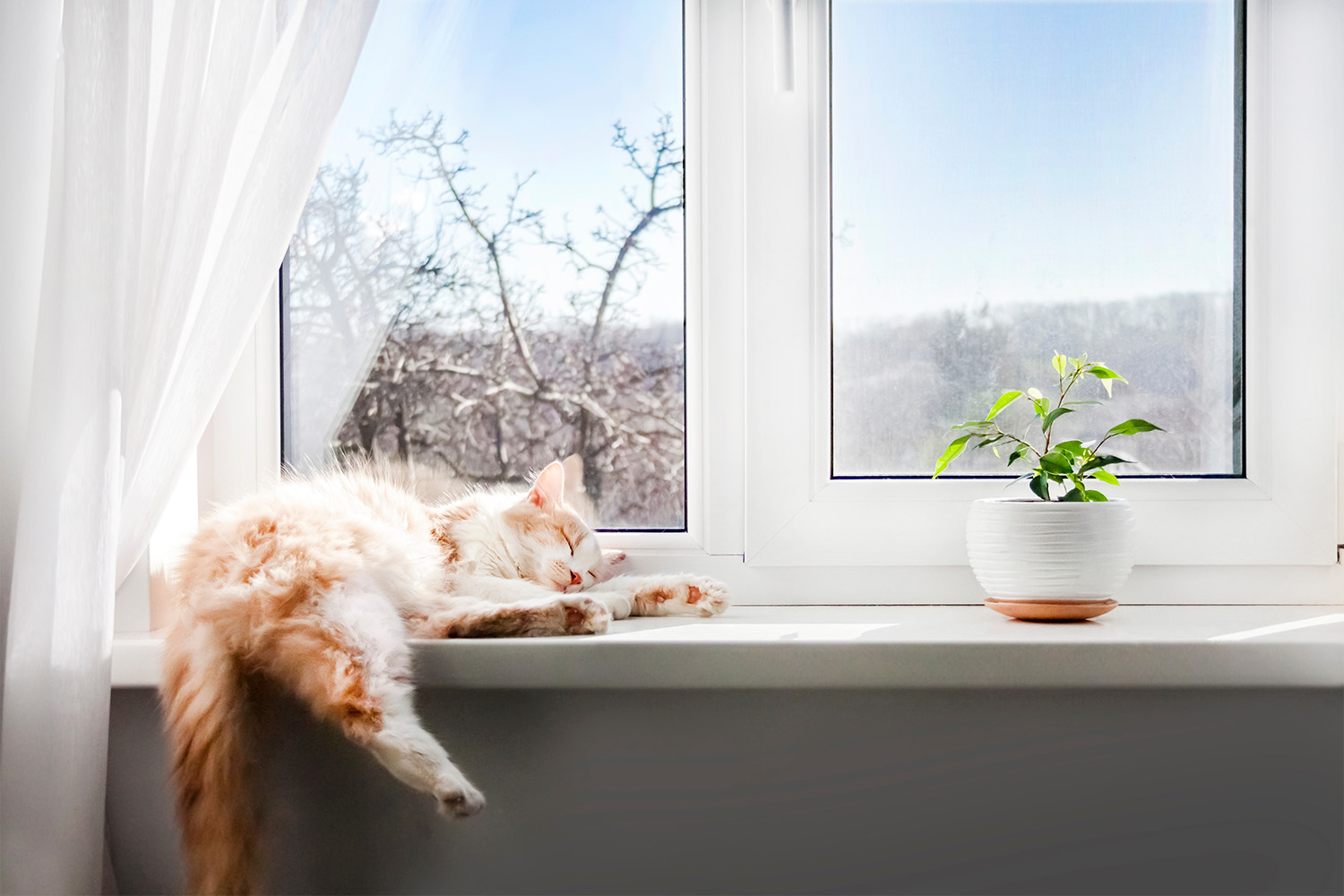If you’ve been thinking about adopting a cat, you might be wondering what steps you can take to ensure they feel safe and comfortable in their new home. There are several things to consider when preparing for their arrival.
Join us as we discuss how to properly cat-proof your house.
What Supplies Do I Need?
One key aspect of cat-proofing your house is making sure you have appropriate supplies to meet their everyday needs. This includes scratching posts and toys to provide them with stimulation and basics such as a litter box and food and water bowls.
Here are a few things to keep in mind when looking for supplies:
Age-Appropriate Diet
A cat’s diet and nutritional needs vary based on their age. Finding the right food for your new feline companion is crucial, as a kitten’s diet would not be suitable for an adult cat, and vice versa. Diet and appropriate activity levels help cats maintain a healthy weight.
Toys
There are a variety of toys available to help keep your new friend active. Take time to find what your cat likes. In terms of structures, your cat might enjoy tunnels or climbing furniture. Hand-held cat toys include toy mice (sometimes filled with catnip), fishing poles/teasers, and balls that make noises. Cats are born with a very strong prey drive and feel fulfilled when they are able to use it, even indoors!
Litter Box Care
If you are adopting a kitten, they might need help when first learning to use the litter box. Animals often navigate their environment through scent, and for this reason, it may be beneficial to use a litter additive or cat attractant litter. Both these options can provide a specific scent that guides them to use the litter box, making it easier for them to understand where to do their business.
(For our older adoptions, most cats are already litter box trained! )
There are a multitude of reasons why cats of all ages could stop using the litter box, even if they are trained to do so. Perhaps your cat finds the litter to be too deep or too dirty. Maybe they want a different type of litter or would prefer for the litter box to be in another location.
If you have an adult or senior cat who stops using their litter box, you may want to consult with experts to find the root cause.
How To Protect Your Belongings From Your Cat
A major part of cat-proofing your house is minimizing access to anything that might be hazardous to your cat.
Let’s discuss some ways you can keep both your home and your cat safe:
Cords
Just like puppies, cats often like to put things in their mouths that they shouldn’t. For any electrical devices that use cords, keep them unplugged when not in use. You might also consider using a cord protector.
Secure Any Harmful Items
Items such as certain human foods or medications meant for humans can be extremely dangerous to cats. Securing these items so that your cat isn’t able to access them can help keep them safe and healthy. Cat/childproof locks on cabinet doors can be a big help here.
Keep Clothes and Towels Out of Reach
Your cat may urinate on soft items as a way of claiming their territory. You might want to keep your favorite clothes and towels off the floor and out of reach to lessen the chances that they will become damaged.
Be Aware of Small Spaces
Many cats are comfortable sleeping in small spaces. Be aware of any spaces where your cat could easily hide, and make sure you know where your cat is before closing off those spaces.
Secure Your Windows
Most cats enjoy sitting on your window sill to look out the window. Keep the windows and window screens secure so your cat won’t be able to escape.
Place Scratching Posts Around the House
Cats will instinctively want to scratch different surfaces around your house. To keep them from scratching your furniture, you can place scratching posts in multiple rooms to help redirect their attention.
Be Careful With Candles
Cats may approach lit candles because they are attracted to light and smoke. You can use candle toppers to minimize the risk of injury, but leaving your cat unattended around an open flame is not ideal.
How Do I Cat-Proof Different Rooms?
Now that we’ve covered the basics for keeping your cat safe and providing them with necessary supplies, you might be wondering how to go about cat-proofing the various rooms of your home more thoroughly.
Let’s get started!
Living Room and Bedrooms
Several things in your living room or bedrooms could be dangerous to your cat. Small items such as pieces from games and toys, sewing supplies, and hair accessories could be harmful if your cat swallows them. Make sure to pick up and put away these things so your cat can’t get to them.
It is best to keep laundry, shoes, and products such as medications and cosmetic supplies out of reach. Your cat can easily jump onto tables and other low surfaces. They may be tempted to play with these items and chew on them if they are accessible.
Driveway and Garage
Clean any chemicals that may have spilled on the driveway or floor of the garage. Products such as antifreeze can prove fatal if ingested.
Put any containers of chemical products out of reach or secure them in some way to prevent your cat from knocking them over.
Bathrooms and Kitchen
Childproof locks can help prevent your cat from getting into cabinets where items such as food and cleaning supplies are stored.
Keeping toilet lids closed and garbage cans either closed or safely stored helps ensure that your cat doesn’t drink or ingest harmful chemicals or food products.
Other Possible Hazards
In addition to those previously mentioned, other common household items could pose a risk to your cat’s safety.
Let’s review some of them:
Blind Strings and Ribbon
Cats may interpret anything left dangling as a toy, which can result in injury. It is best to keep blind strings out of reach so that your cat isn’t tempted to play with them.
Despite what we see in cartoons, cats shouldn’t play with string or yarn since these are choking hazards and may get stuck in the intestinal tract. Keep these items off the floor (and any other low surfaces your cat could jump onto).
House Plants
House plants should be out of reach, as many common house plants can be poisonous to animals, including aloe vera, holly, snake plants, and more.
Keep in mind that cats are agile and may be able to access hanging plants simply by climbing onto surrounding surfaces.
Food Wrappers
There are a number of foods that can be toxic to cats, but wrappers can also be dangerous. Properly dispose of any food-related trash to prevent your cat from finding them.
Things To Keep in Mind
Remember that even if you take precautions and cat-proof your house thoroughly, there could still be times your cat gets into things they shouldn’t have. Luckily, some younger cats may outgrow some behaviors with training.
However, cats of all ages are born to be curious about their surroundings and find a way to access things that aren’t meant for them. The best thing you can do is try to curb unwanted behaviors before they become a habit. Provide ample stimulation so, over time, they gravitate towards toys instead of items in your house.
It may take some time for your furry family member’s personality to start showing, but once they become comfortable in your home, it is likely they will open up more.
Introducing new toys is a great way to build a relationship with your new feline friend. As you begin to notice what they like to play with, you can learn more about their personality.
For more advice on caring for your feline friend, you can join AskVet for only $9.99 a month and receive 24/7 access to Certified Pet Lifestyle Coaches™ who can help you form an individualized pet care plan perfect for your pet’s needs.
Join AskVet today and get the support you need immediately.
Sources:
Pet-Proofing Your Home | American Humane
Top 5 Ways to Prep Your Home for a Puppy or Kitten | ASPCA
Tried & True: The Necessary Guide to Cat-Proof Your House | Goldorado Animal Hospital







